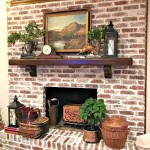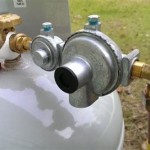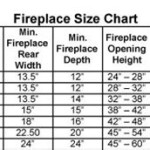Maintaining a Clean Brick Fireplace Front
A brick fireplace serves as a focal point in many homes, providing warmth and aesthetic appeal. However, the porous nature of brick readily absorbs smoke, soot, and other byproducts of combustion, leading to a dingy and unattractive surface. Proper cleaning and maintenance are essential for preserving the fireplace's appearance and extending its lifespan. This article provides a comprehensive guide on effectively cleaning a brick fireplace front, outlining different methods and preventative measures.
Understanding the Challenges of Cleaning Brick
Brick's porous structure presents unique cleaning challenges. Unlike smooth, non-porous surfaces, brick absorbs liquids and particles deep within its pores. This means that surface cleaning alone is often insufficient to remove embedded stains and soot. Furthermore, the type of brick used, its age, and previous treatments (such as sealing or painting) can all impact the cleaning process. Harsh chemicals can potentially damage the brick, mortar, or any existing coatings, highlighting the need for careful selection of cleaning agents and methods. Identifying the nature of the staining is crucial before embarking on any cleaning process. Is it primarily soot and smoke residue, or are there other types of stains, such as efflorescence (salt deposits), mold, or mildew?
Mortar joints, being even more porous than brick, are particularly susceptible to staining and deterioration. When cleaning, it’s important to avoid excessively aggressive scrubbing that could erode the mortar. Damaged or crumbling mortar can not only detract from the fireplace's appearance but also compromise its structural integrity.
Prior to cleaning the entire fireplace, it's recommended to test the chosen cleaning method on a small, inconspicuous area. This allows assessment of its effectiveness and potential impact on the brick's color and integrity. It also provides an opportunity to adjust the cleaning solution's concentration or the scrubbing technique if necessary.
Effective Cleaning Methods for Brick Fireplace Fronts
Several methods can be employed to clean a brick fireplace front, ranging from simple household solutions to more specialized cleaning products. The choice of method depends on the severity of the staining and the type of brick.
Dry Cleaning: For light soot and dust accumulation, a dry cleaning approach is often sufficient. Start by using a stiff-bristled brush (avoid wire brushes, as they can scratch the brick) to sweep away loose debris. A vacuum cleaner with a brush attachment can also be used to remove surface dirt from the brick and mortar joints. This preliminary step is essential to prevent grinding dirt deeper into the brick during subsequent wet cleaning.
Water and Mild Detergent: For more stubborn dirt, a solution of warm water and a mild detergent (such as dish soap) can be effective. Mix a small amount of detergent in a bucket of warm water. Using a soft sponge or brush, gently scrub the brick surface. Avoid excessive scrubbing, especially on mortar joints. Rinse the area thoroughly with clean water to remove any detergent residue. This method is suitable for general cleaning and removing light soot accumulation.
Baking Soda Paste: Baking soda is a gentle abrasive and can be used to create a cleaning paste. Mix baking soda with water to form a thick paste. Apply the paste to the stained areas and allow it to sit for 15-20 minutes. Scrub gently with a soft brush or sponge and rinse thoroughly with clean water. Baking soda is particularly effective for removing grease and some types of stains. Its mild abrasive nature helps lift dirt without damaging the brick.
Vinegar Solution: White vinegar is a natural cleaning agent that can help remove soot and mineral deposits. Mix equal parts white vinegar and water in a spray bottle. Spray the solution onto the brick surface and allow it to sit for a few minutes. Scrub gently with a brush or sponge and rinse thoroughly with clean water. Vinegar is acidic, so it's important to test it on an inconspicuous area first to ensure it doesn't discolor the brick. Vinegar can also help neutralize odors associated with smoke and soot.
Commercial Brick Cleaners: Several commercial brick cleaners are available on the market. These products are specifically formulated to remove soot, stains, and efflorescence from brick surfaces. When using commercial cleaners, it's crucial to follow the manufacturer's instructions carefully. Always wear appropriate safety gear, such as gloves and eye protection, and ensure adequate ventilation. Some commercial cleaners contain harsh chemicals that can be harmful if not used properly. Choose a cleaner that is specifically designed for the type of brick you have (e.g., clay brick, concrete brick).
Steam Cleaning: Steam cleaning is a method that uses high-temperature steam to loosen dirt and grime. A steam cleaner can be used to clean the fireplace front, but it's important to use a low-pressure setting to avoid damaging the brick or mortar. Steam cleaning can be particularly effective for removing embedded soot and grease. The heat from the steam also helps to sanitize the surface.
Preventative Measures and Maintenance
Preventing soot buildup and stains is essential for maintaining a clean brick fireplace front. Several preventative measures can be taken to minimize the need for frequent cleaning.
Regular Cleaning and Maintenance: Regular cleaning is the most effective way to prevent soot buildup. Wipe down the fireplace front with a damp cloth or sponge after each use. This will remove any loose soot or ash before it has a chance to become deeply embedded in the brick. Periodically vacuum the area around the fireplace to remove dust and debris that can contribute to staining.
Proper Fireplace Operation: Ensure the fireplace is properly ventilated and that the chimney is clean and free of obstructions. A clean chimney allows for proper airflow, reducing the amount of smoke and soot that accumulates on the fireplace front. Have the chimney inspected and cleaned annually by a qualified professional.
Using Seasoned Wood: Burning seasoned wood is crucial for minimizing smoke production. Seasoned wood has a lower moisture content, resulting in a cleaner and more efficient burn. Avoid burning green or wet wood, as it produces excessive smoke and creosote, which can contribute to staining and increase the risk of chimney fires.
Applying a Brick Sealer: Applying a brick sealer can help protect the brick from staining and make it easier to clean. A sealer creates a barrier that prevents soot and other contaminants from penetrating the brick's surface. Choose a sealer that is specifically designed for brick and follow the manufacturer's instructions carefully. Sealing is not a universal solution however as some brick needs to “breathe” to avoid moisture build up internally. Research and potentially engage a professional is necessary to discern if your brick type is suitable for sealing.
Addressing Cracks and Damage: Repair any cracks or damage to the brick or mortar as soon as possible. Cracks can allow moisture to penetrate the brick, leading to further deterioration and staining. Damaged mortar can also provide a breeding ground for mold and mildew. Repairing these issues promptly will help maintain the fireplace's structural integrity and appearance.
Proper Airflow and Ventilation: Ensuring proper airflow and ventilation in the room can also help minimize soot buildup on the fireplace front. Adequate ventilation helps to remove smoke and other airborne particles from the room, reducing the amount that settles on surfaces. Consider using an air purifier to further improve air quality.
Consider a Fireplace Screen or Doors: A fireplace screen or doors can help contain sparks and embers, reducing the amount of soot and ash that escapes into the room and settles on the fireplace front. Screens and doors also add an extra layer of safety, preventing sparks from landing on carpets or furniture.
By implementing these preventative measures, homeowners can significantly reduce the need for intensive cleaning and maintain the beauty of their brick fireplace front for years to come.

Mortar Wash Brick Fireplace Makeover Dimples And Tangles

How To Clean Brick Fireplaces Mantels Hearths And More My Space

Mortar Wash Brick Fireplace Makeover Dimples And Tangles

How To Clean A Fireplace Diy Basics

How To Clean A Fireplace Diy Basics

Whitewash A Brick Fireplace

How To Whitewash Fireplace Brick Allisa Jacobs

How To Paint A Brick Fireplace Beamin Moore

How To Clean Fireplace Bricks 9 Steps With S Wikihow

How To Paint A Brick Fireplace Young House Love
Related Posts








